LED Energie brand LED bulb with following data stopped to work properly:
230V 50Hz 7W E27
450lm 3000K 60mA 20D
3684 Mod.5161
So lets make a tear-down
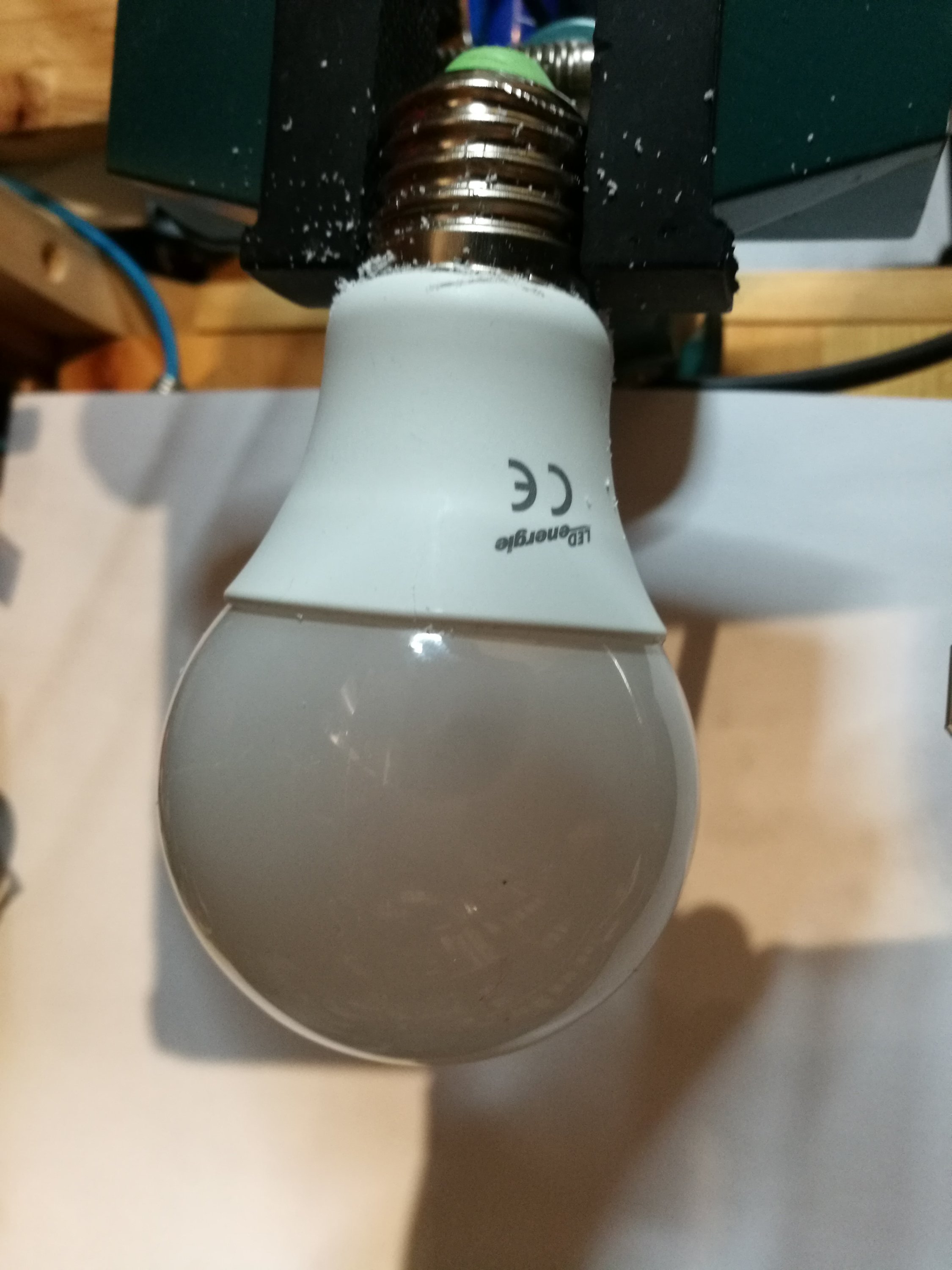
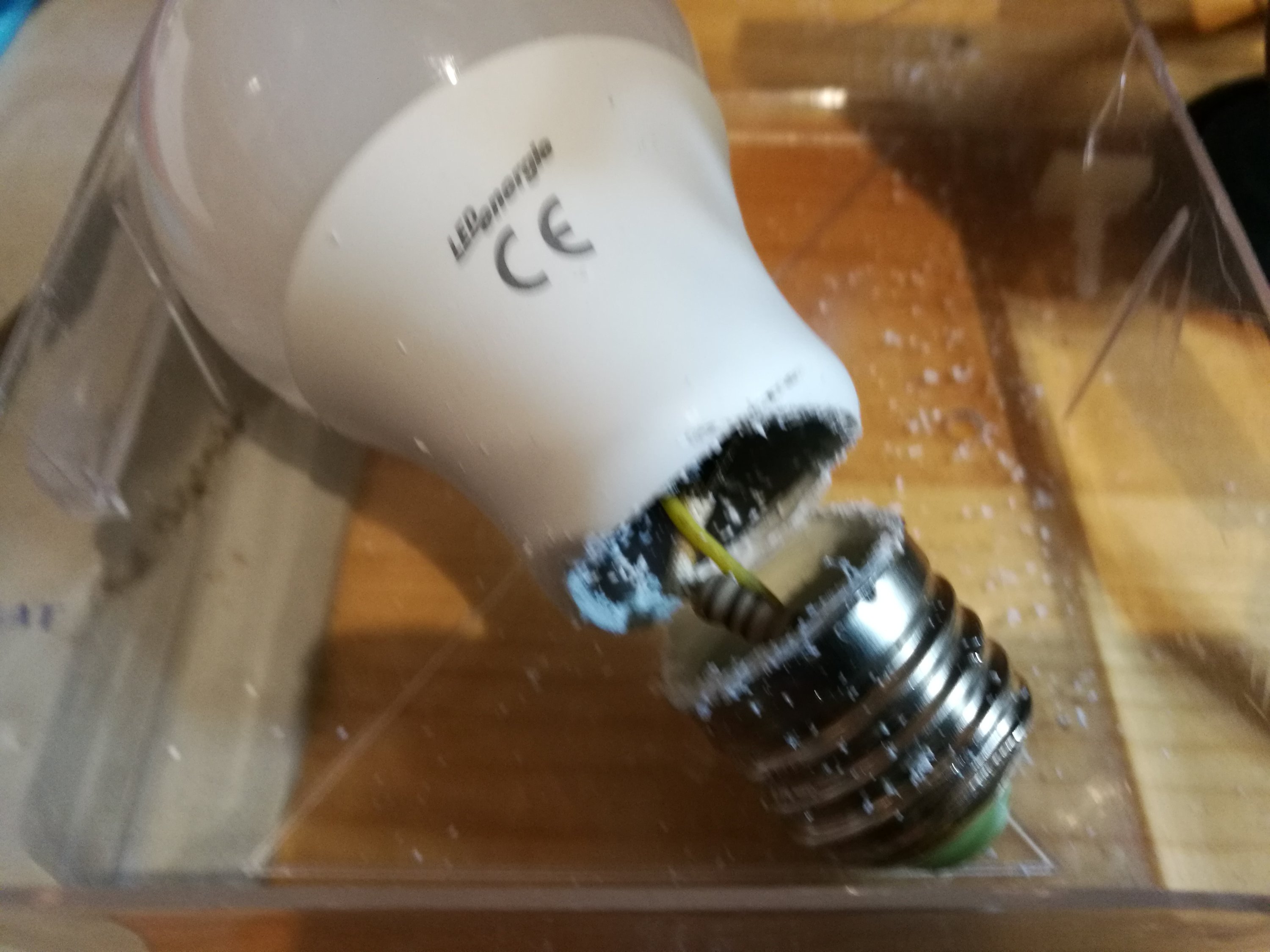
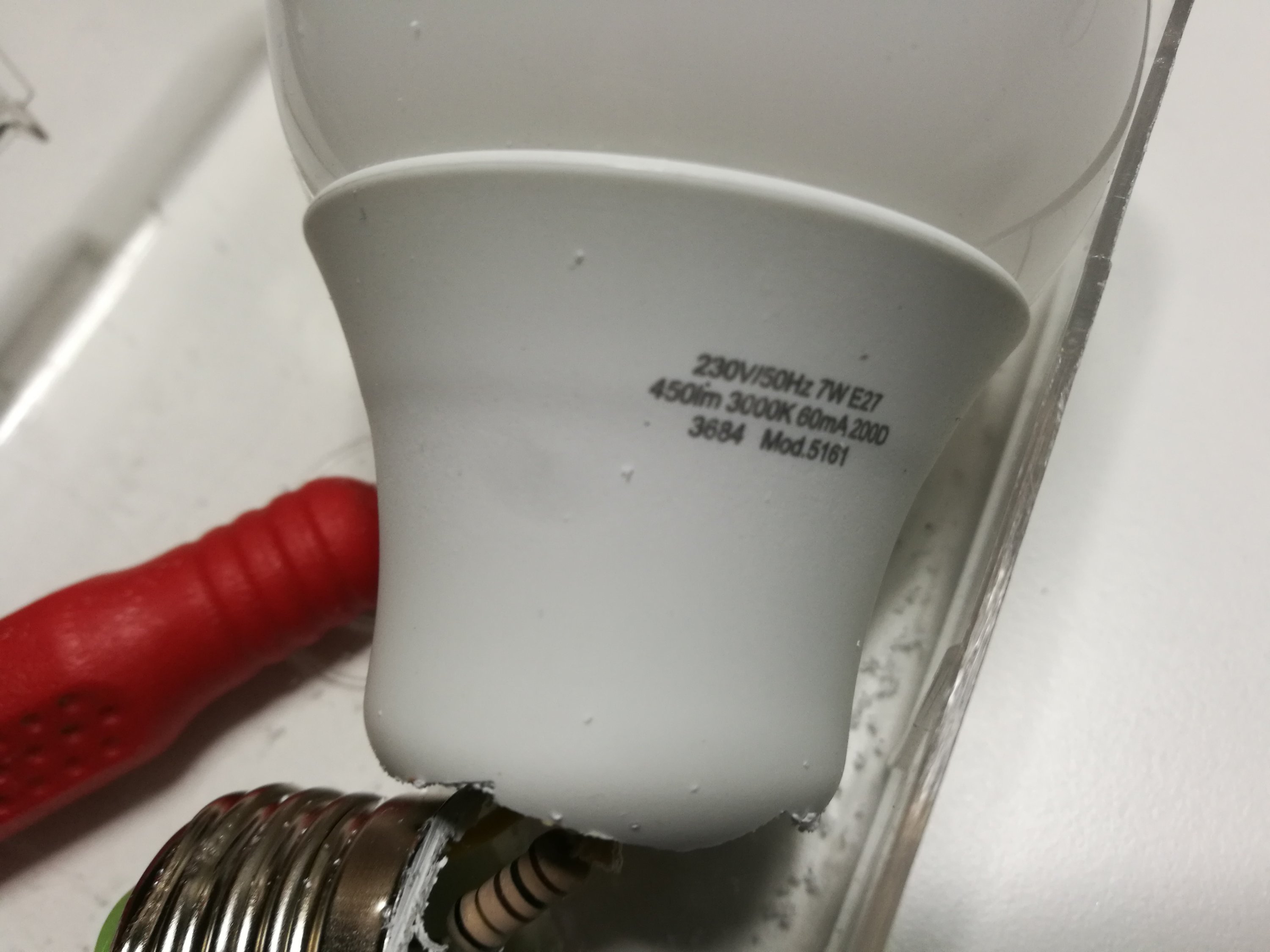
Inside
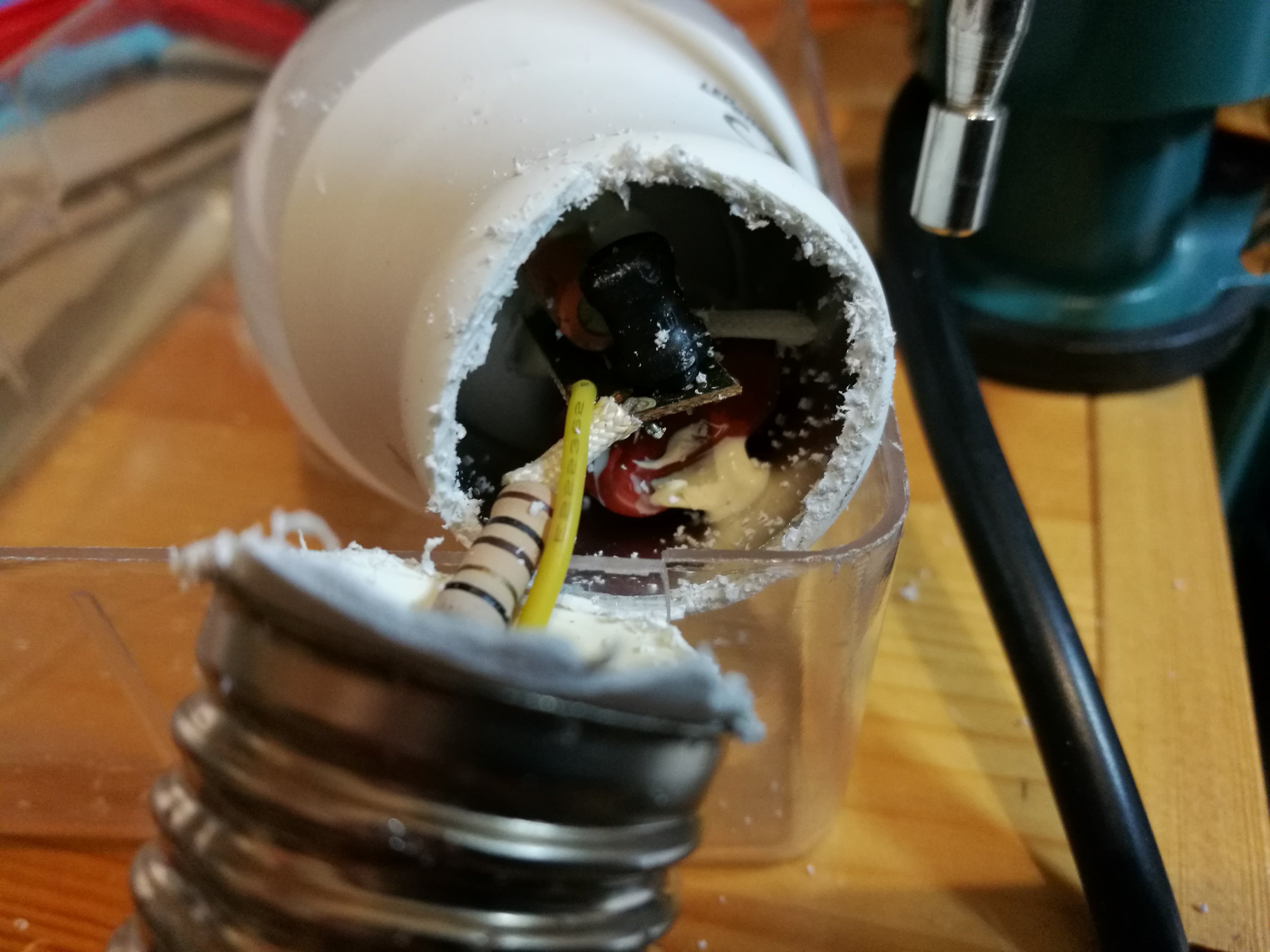
There seems to be 20 small LEDs in series inside bulb and one of them burned black. As such this LED string is expected to need around 70V over it. LEDs were soldered to a aluminium circuit board thar was glued to aluminium tube inside plastic lamp base part.
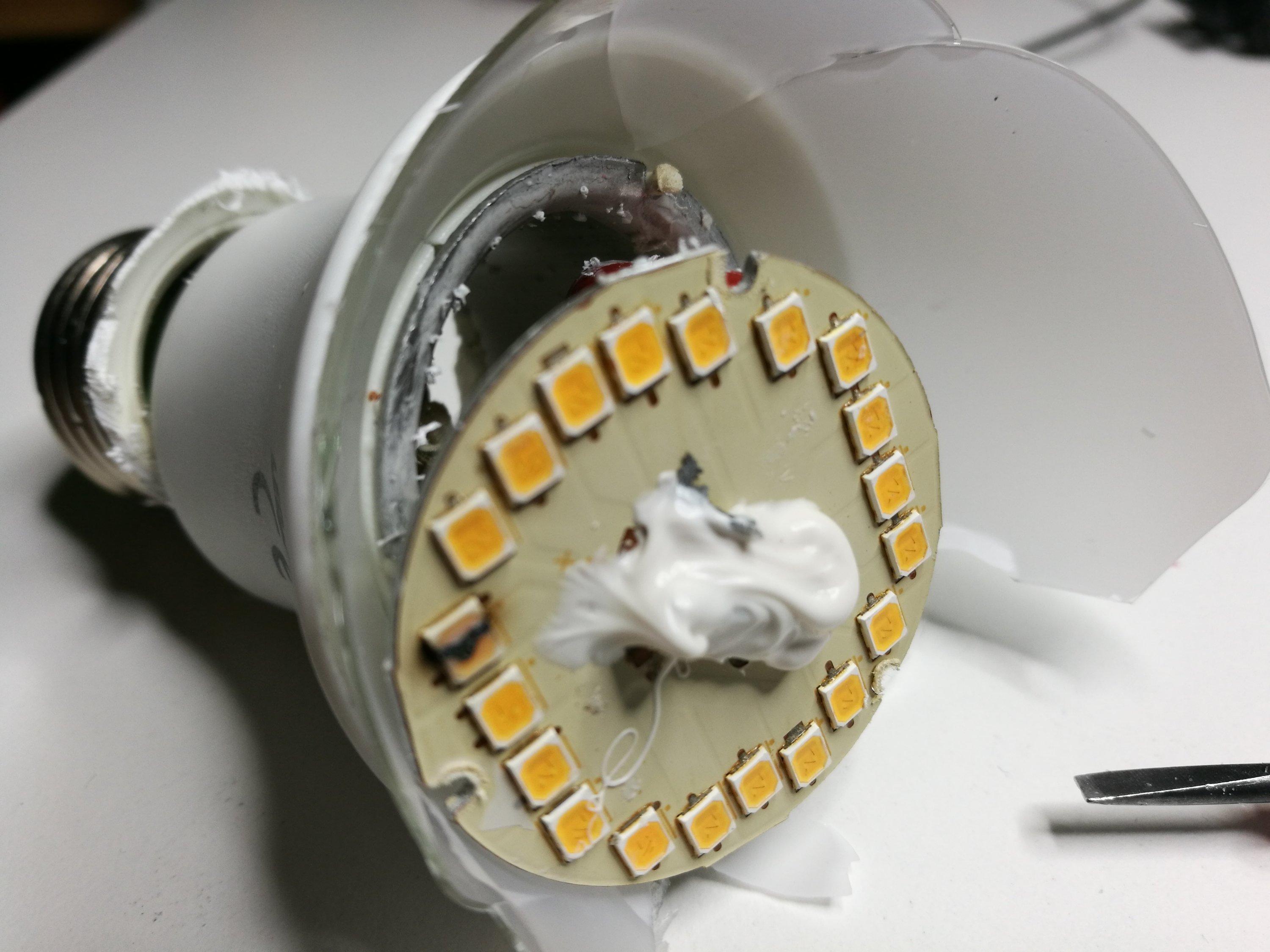
Look at the circuit board
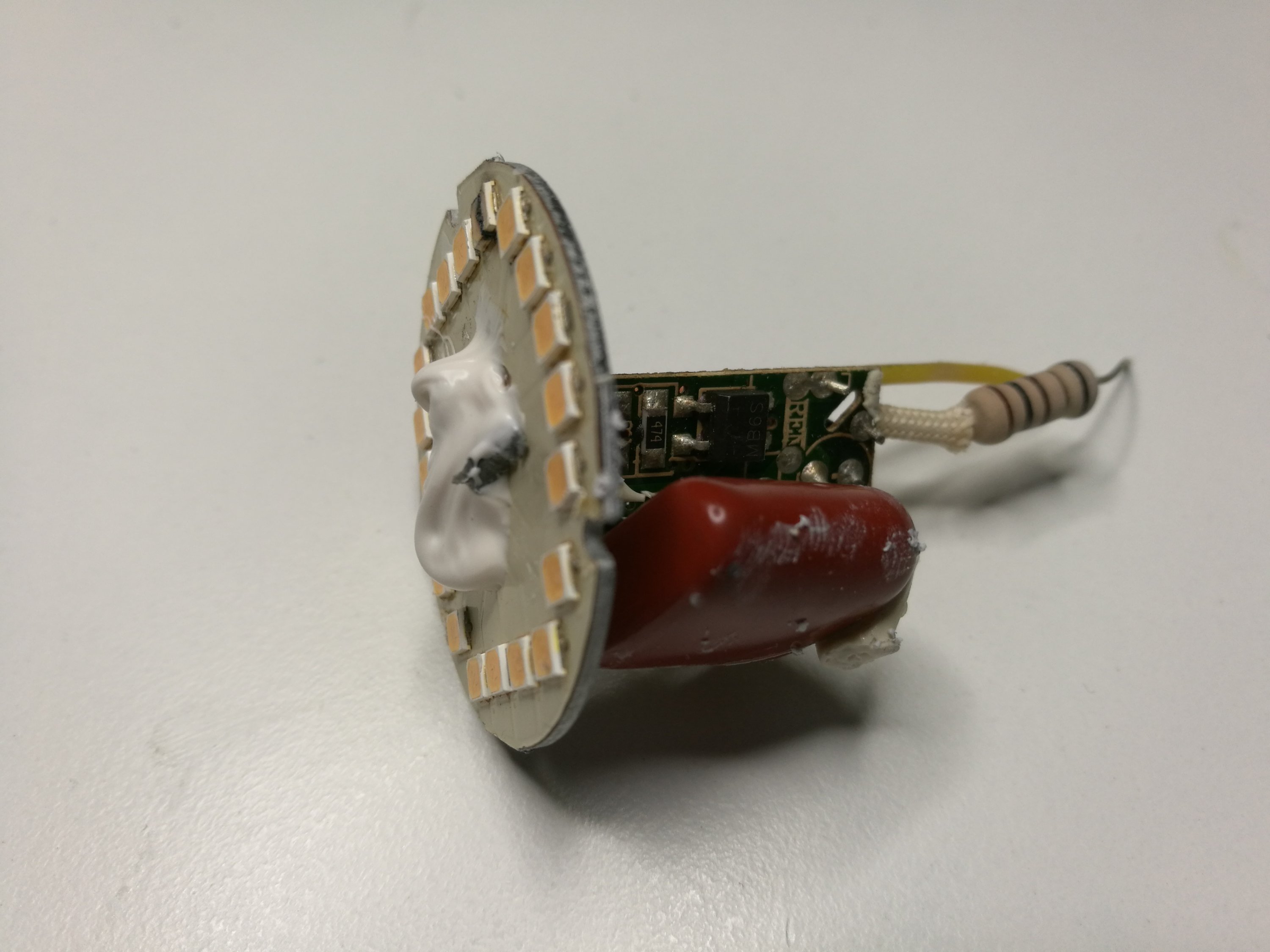
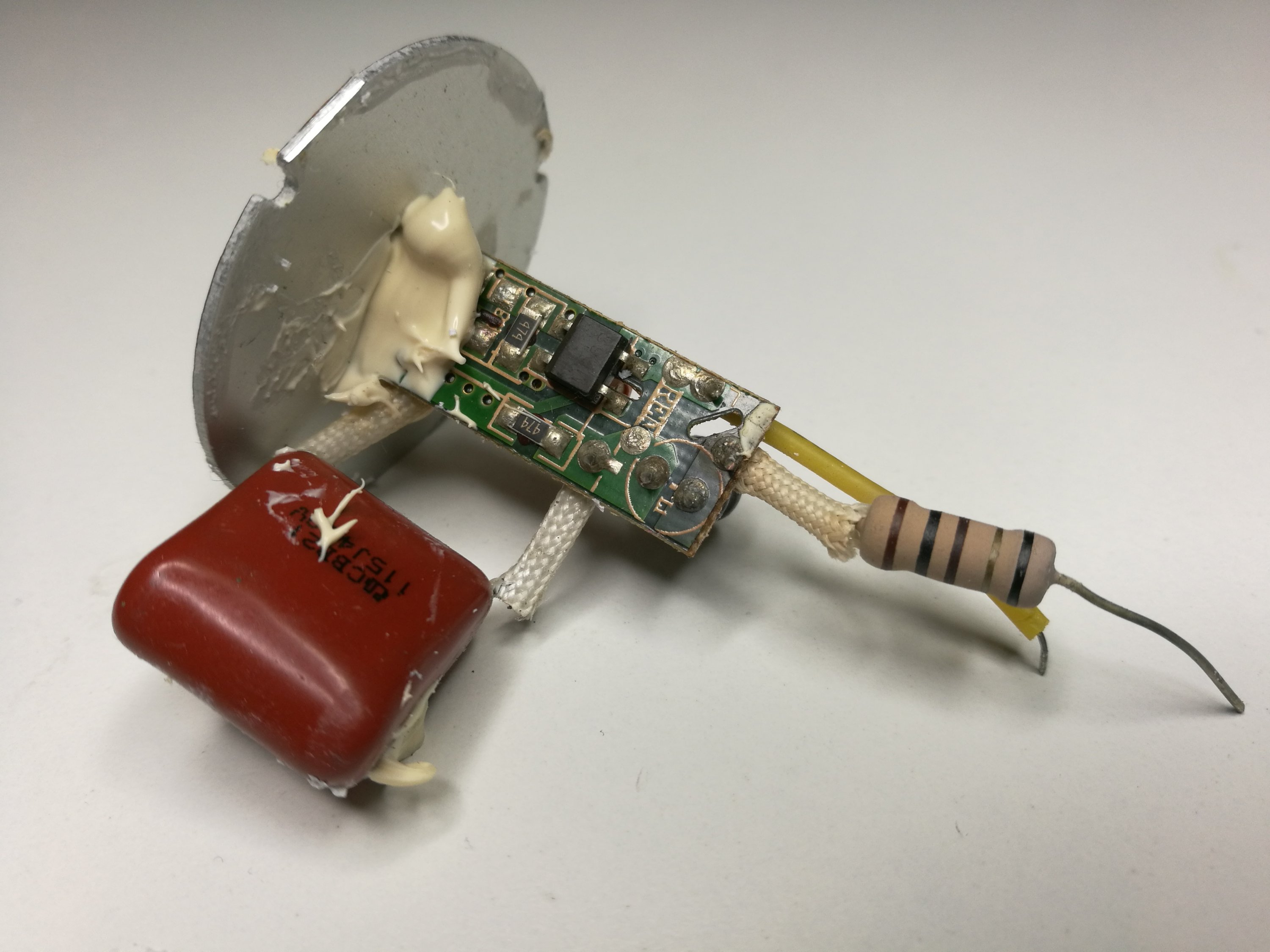
This looks like power supply is basically an RC current limiting (with small coil) followed by rectifier and small electrolytic filtering capacitor. In addition there are 470k bleder resistors to discharge capacitors.
The big resistor is a bit suspect here. According to color code it should be 100 ohms, but multimeter reading says 295 ohms. I suspect that either it has changed value or color code has changed colors due heating.
The RC circuit capacitor was 1.1uF 400V. The filter capacitor after rectifier was 2.2uF 400V electrolytic.
Here is the reverse-engineered circuit disgram:

197 Comments
Tomi Engdahl says:
Christmas special Turn Any LED bulb into colourful RGB light| Maryy Christmas
https://m.youtube.com/watch?v=1I4pQi12GLw&feature=youtu.be
Tomi Engdahl says:
What happens when you provide too much power to an LED?
https://www.youtube.com/watch?feature=youtu.be&v=GYwVelTCdAI
Tomi Engdahl says:
Make your own Dooby lamps – DIY Dubai lamps (strobing alert)
https://www.youtube.com/watch?v=ISTB0ThzhOY
A test to see if ordinary LED lamps can be under-run like Dubai lamps to make them last longer with reduced intensity and heat.
To limit the current I used different values of series capacitor, which has a soft limiting effect, making it compatible with traditional capacitive dropper and linear regulator based lamps.
This technique does not work with some lamps with switchmode based power supplies. They will tend to strobe due to the way the circuitry works.
This project involves mains voltage, and suitable precautions should be taken during your experimentation.
Tomi Engdahl says:
https://hackaday.com/2021/02/09/teardown-bug-zapper-bulb/
Tomi Engdahl says:
https://bikerglen.com/blog/color-kinetics-colorburst-6-teardown/
Tomi Engdahl says:
Exploring a Chinese magnetic “machine light” (with schematic)
https://www.youtube.com/watch?v=UDrQ5aiCdJg
Specifically sewing machines, but it does have other uses where you need a splash of light.
By Chinese standards it’s actually quite well made and functional. The circuitry is good and the LEDs are an interesting type being run at a sensible level that will ensure a long life.
This seems to be designed for Chinese factories, so I think it’s only available in 220V. But it will still light on 120V.
Tomi Engdahl says:
Bodging a repair on a faulty ground uplighter
https://www.youtube.com/watch?v=4goqsDGro7w
This is a faulty ground recessed uplighter that was sent for our exploration by Douglas.
It’s a classic example of premeditated landfill, with no replaceable lamp and a sealed case to try and stop water getting in.
They are often mounted into a buried enclosure to ensure that anyone who works on them has to kneel on wet ground and fumble in stinky water to try and make a waterproof connection onto a cable that gets shorter every time a fitting is replaced. They’re usually powered from panels where all the RCDs/GFCIs have been bypassed to “fix the tripping issues”. (Not a good thing.)
You can see this type of light littering the pavements of cities and “architectural” areas. They either shoot light pointlessly into space while dazzling pedestrians, or put blotchy skidmarks of light up the side of buildings. They are notable for flickering gently as their corroded LEDs light the internal drops of water on their lens, and occasionally emitting steam from their submerged electrical connections.
Tomi Engdahl says:
Opening the 1W Dubai lamp (with schematic)
https://www.youtube.com/watch?v=AM2DMuryw_A
The smaller lamp bases often make it hard to fit decent drive circuitry into an LED lamp. Many manufacturers skimp by just having a low voltage ceramic capacitor and rectifier. But Philips have put some very interesting circuitry into this lamp.
The lamps you’re not allowed to have. Exploring the Dubai lamps
https://www.youtube.com/watch?v=klaJqofCsu4
Tomi Engdahl says:
Crushing and hacking LED lamps
https://www.youtube.com/watch?v=H09SI5qLmtY
A very pleasant evening spent crushing and hacking some very similar looking LED lamps from different brands.
If you have a go at crushing the plastic, then make extra sure it’s not glass, plastic coated glass or hard brittle plastic, to avoid getting cut. Gloves might be a good idea.
The hack involves the current sensing resistors. As the LED current flows through them the voltage across them rises up until it reaches a threshold where the circuitry effectively increases its resistance until a current balance is reached. Sometimes there’s one resistor, but often there are two in parallel to allow fine tuning of the current. By dismembering one you can make the lamp run at much lower current and temperature. This makes the lamp run more efficiently and it will also last much longer than in its original form.
Tomi Engdahl says:
LED Spaghetti – flexible LED filaments
https://www.youtube.com/watch?v=3ARnm8BxHeA
Tomi Engdahl says:
So Many MISERABLY FAILED LED Lights
https://www.youtube.com/watch?v=lIK1jnYr0yw
Making ANY cheap design will cause failure and is more wasteful. STOP IT!
Tomi Engdahl says:
Make EPIC custom crystal lamps
https://www.youtube.com/watch?v=HZKu9QMN5xw
To make these customised lamps you can use the openscad scripts included at the bottom of this video description area.
Tomi Engdahl says:
The cheap Chinese bulb that won’t turn off
https://www.youtube.com/watch?v=1uEmX5XClPY
These LED bulbs will continue to draw power from the mains indefinitely even once they’re switched off and the circuit is broken. But how?!
Tomi Engdahl says:
Doobying a cheap LED floodlight with lux/efficiency readings
https://www.youtube.com/watch?v=biEZ1TbdhhU
During the stream I hooked capacitors in series with a cheap sealed 10W LED floodlight that is almost certainly baking its LEDs. This reduces intensity, but multiplies its lifespan significantly.
This time I used a light meter to get an indication of how the intensity changed with current, and got a rough approximation of “lux per watt” at a height of 300mm (12″) from the front of the light. This was not an ideal testing scenario and is just for comparison on intensity.
One of the most notable things was how the efficiency dropped as the light heated up when running at full power. LEDs are less efficient at higher currents and when they are hot, so modern lights are not only designed to fail fast for profit reasons, but also perform badly as they do so.
Here are the results.
Full power cold 10.7W, 3010 lux, 281 lux per watt.
Full power hot 10.7W, 2800 lux, 261 lux per watt.
1uf, 3.8W, 1460 lux, 384 lux per watt. (Capacitor voltage drop 62V)
470nf, 1.9W, 840 lux, 442 lux per watt.
330nf, 1.5W, 640 lux, 426 lux per watt.
220nf, 1W, 450 lux, 450 lux per watt.
100nf, 0.5W (estimated), 210 lux, 420 lux per watt. (Capacitor voltage drop 90V)
47nf, 0.2W (estimated), 90 lux, 450 lux per watt.
22nf, 0.1W (estimated), 30 lux, 300 lux per watt.
At the lower levels the light’s internal leakage shunt resistor would be affecting efficiency.
Tomi Engdahl says:
I wrecked B&Q’s biggest LED lamp then bodged a repair
https://www.youtube.com/watch?v=Hcztjhyl6GM
A teardown of B&Q’s (like Home Depot) biggest lamp. It didn’t go to plan.
Things worthy of note. If opening one of these, you have to remove the two screws from the LED panel – as they aren’t just tapped into the aluminium heatsink plate, but into plastic pillars that hold everything in.
Given the poor thermal coupling and 15.5W rating for such a small LED PCB I wonder if they melt those pillars. The base has reasonable heatsinking capability, but the poor contact hints at a short lamp life.
I’m surprised that this lamp isn’t in the same style of the common single PCB lamps with a linear current regulator on the same panel as the LEDs. Especially given its high power rating. I guess they may evolve in that direction in the future, as it is a much simpler way of creating the high power lamps.
Tomi Engdahl says:
Hacking an extra trashy Poundland LED lamp (with schematic)
https://www.youtube.com/watch?v=5HTa2jVi_rc
Tomi Engdahl says:
New LED lamp twist reverse engineered from a picture
https://www.youtube.com/watch?v=toXaBxp1It8
Just when you thought they couldn’t make an LED lamp simpler than the common linear regulator type, they come out with this.
It’s basically a single package combining the rectifier and current regulator into a single package.
These lamps work by using enough multi-chip LEDs in series to approach the normal mains voltage, but then use a linear current regulator to keep the current constant by acting as an active resistor, with a small voltage dropped across it.
Tomi Engdahl says:
Dimming LED lamps with ordinary dimmers.
https://www.youtube.com/watch?v=fWh2obSY0dQ
Using a traditional phase angle control wall-plate dimmer (the usual type) is just a terrible way to dim LED lamps. The rough chopping of a 50/60Hz sinewave with sharp voltage transitions is very hard to convert to a proper smooth and flicker free dimming of an LED lamp over a decent range. LED lamps also provide a very low load with sudden drop-off of current which can make ordinary dimmers very unstable.
Tomi Engdahl says:
Philips streetlight “ledgine” fault and repair
https://www.youtube.com/watch?v=cH3OUCabVAY
This is an unusual one. It’s the very hefty LED module out of a streetlight, that has failed prematurely.
The failure mode is odd. The high open circuit voltage from the universal Xitanium driver has resulted in tracking on the aluminium core PCB, that has progressively burned along a thin copper track, eating right through to the aluminium layer to sustain the tracking current.
Tomi Engdahl says:
https://hackaday.com/2021/05/27/investigating-a-new-chip-in-a-minimalist-led-lamp/
Tomi Engdahl says:
Doom ported to the Silicon lab’s MGM210L RF module found in the IKEA TRÅDFRI RGB GU10 light bulb (IKEA model: LED1923R5).
https://www.youtube.com/watch?v=7ybybf4tJWw
Tomi Engdahl says:
UPDATE: In the github repository we have removed the mip-mapping on composite textures, with no performance penalty, so graphics will be more detailed than what is shown in this video.
Links:
Article on next-hack website:
https://next-hack.com/index.php/2021/…
Article on Hackaday.io:
https://hackaday.io/project/180182-ha…
Github repo:
https://github.com/next-hack/MG21DOOM
Tomi Engdahl says:
Hacking a Poundland solar light with intriguing design fault
https://www.youtube.com/watch?v=zkEuCdPxn98
The choice of Poundland lights has been disappointing this year so far. That’s not surprising, given the logistics problems caused by the pandemic.
This is a light they’ve had for a few years, but the style has evolved from time to time. It’s very effective, especially with the neat bit of bubbled plastic light-guide.
The circuitry has the extra components required to use a colour changing LED, although it runs the LED at such a low current that the lower voltage red LED tends to dominate colours that include red. (magenta, yellow and white)
It’s actually worth getting these just for the PCB to fix other lights. But you can also hack these to make them single colour, two different colour LEDs wired in series, or add an LED socket as in this video.
Tomi Engdahl says:
LED shock hazards are increasing
https://www.youtube.com/watch?v=FeKL82V3p-Q
I’m getting more messages from people who are receiving shocks from faulty LED lights – especially flood lights.
The problem is caused by internal arcing that occurs in LEDs when they are part of large series strings being driven by high voltage supplies. When the LED fails open circuit it starts to arc and track internally, often causing flickering of the light in the process.
Because the aluminium substrate LED panels have an extremely thin layer of insulation between the copper and aluminium, it is easy to damage it when an LED burns up, especially the newer directly mounted flip-chip LEDs. This results in a conductive path to the aluminium, which may not be grounded.
The thin layer of insulation also causes unusual effects when people touch ungrounded LED lights with the switch on the neutral, and the LEDs glow because the person touching the ungrounded light provides a ground path for capacitively coupled current from the LED panel.
With the high number of improperly grounded LED floodlights coming into the country via direct import or from distributors who have not tested their imported products properly, the risk of shock from outdoor lights (and some indoor lights) is increasing. This introduces a few secondary hazards. A metal fence or structure that the light is mounted to may become live, any shock from a light at height could result in a fall and the effects of rectified DC current leakage may affect the ability of some RCD/GFCI devices to trip, and may also prevent tripping when AC leakage occurs from another fault/shock.
I’d recommend that extra precautions are taken to fully isolate faulty metal cased LED lights before working on them, and if there is any doubt about the power source then insulated gloves should be worn and work should only be done in dry weather.
I’d also recommend that the ground integrity of lights is properly tested, and lights with flimsy copper coated aluminium flex have it replaced with something more appropriate if possible.
It’s best to source new lights from prominent suppliers in your country that have a reputation to uphold. That automatically excludes most eBay and amazon sellers.
Tomi Engdahl says:
Using LEDs as mains indicator lights on 120V and 230V (live demos)
https://www.youtube.com/watch?v=Q23uh7AjjXw
Modern LEDs are bright enough at low current to use as directly mains powered indicators with minimal circuitry. The slight downside is that with a simple resistor circuit the vast majority of the power gets wasted as heat. But the current is so low anyway that it doesn’t really matter. Here are some simple ways to drive LEDs from 110V to 240V with minimal circuitry.
I tend to recommend running resistors at around half their rating at worst as it means they will last a long time and not discolour too much with age.
Viewer comments:
Bloody hell Clive, watching your hands around those live contacts, I’m a know you know what you are doing, but it still made my bottom pucker.
In my opinion that was one of your best videos clive! Very informative and entertaining. You’re like the bob ross of electronics with your calm voice.
I always get a bit nervous seeing your hand 1cm away from a live wire
My favorite approach is to use “capacitor dropper” method (as in your video) but with two LEDs in parallel and opposite directions. This allows current to flow in both directions and you can get rid of the bridge rectifier.
How do you tell the difference between the similarly coloured LEDs of differing technology just by looking at them (not powered)? Is it just from using them for such a long time?
Tomi Engdahl says:
LED shock hazards are increasing
https://www.youtube.com/watch?v=FeKL82V3p-Q
I’m getting more messages from people who are receiving shocks from faulty LED lights – especially flood lights.
The problem is caused by internal arcing that occurs in LEDs when they are part of large series strings being driven by high voltage supplies. When the LED fails open circuit it starts to arc and track internally, often causing flickering of the light in the process.
Because the aluminium substrate LED panels have an extremely thin layer of insulation between the copper and aluminium, it is easy to damage it when an LED burns up, especially the newer directly mounted flip-chip LEDs. This results in a conductive path to the aluminium, which may not be grounded.
The thin layer of insulation also causes unusual effects when people touch ungrounded LED lights with the switch on the neutral, and the LEDs glow because the person touching the ungrounded light provides a ground path for capacitively coupled current from the LED panel.
With the high number of improperly grounded LED floodlights coming into the country via direct import or from distributors who have not tested their imported products properly, the risk of shock from outdoor lights (and some indoor lights) is increasing. This introduces a few secondary hazards. A metal fence or structure that the light is mounted to may become live, any shock from a light at height could result in a fall and the effects of rectified DC current leakage may affect the ability of some RCD/GFCI devices to trip, and may also prevent tripping when AC leakage occurs from another fault/shock.
Tomi Engdahl says:
Poundland Harry Potter style floating candles
https://www.youtube.com/watch?v=zxEFTXpnMAM
These turned out to be pretty good. Initially when I saw the box I thought they were just floating tealights, but it turns out they are slender electronic flickering candles that come with a hook and very fine clear thread to suspend them in the air.
Tomi Engdahl says:
non dimmable LED dimmed
https://www.youtube.com/watch?v=gfp4P3mTs5g
Dimming a non dimmable led lamp
So it is dimmable just does not use full range bc of forward voltage, thats fine by me
Which dimmer was used?
An industrial variac dimmer
Tomi Engdahl says:
The lamps you’re not allowed to have. Exploring the Dubai lamps
https://www.youtube.com/watch?v=klaJqofCsu4
Tomi Engdahl says:
104 LED filament lamp – just because….
https://www.youtube.com/watch?v=hFtfMtFSD8A
What initially started as a rough rig to test some bulk LED filaments from Aliexpress, turned into an attempt at making a really big LED filament lamp.
It has to be said that side by side, the 12 filament Philips Dubai lamp appeared brighter at a similar power. So the Philips LEDs are definitely higher efficiency.
None of the filaments supplied in this batch were broken, there were a few that had clearly been weeded out in the factory, and they provided a few extra. The packaging was simple with the three strips of filaments on a piece of cardboard and wrapped with film. Antistatic packaging would be preferred, but they seem to have survived shipping well.
The cost was £10 per set of 100 filaments, but that may go up if lots of orders are placed.
Tomi Engdahl says:
Inside a cheap Aliexpress 12V LED light
https://www.youtube.com/watch?v=sMtubTHJybM
This is a useful 12V light in a very common form factor that seems to have become a standard. The bizarre name “purification light” actually makes it easier to find these online. The same style of light is referred to as a grill fitting by CPC (A prominent UK supplier).
The light comes with a double sided foam adhesive strip and also the more traditional concealed metal clips for attachment to a surface. The foam strip may be useful for vehicle use, but the clips would be preferable for wall or ceiling mounting indoors.
The circuitry is refreshingly simple – just LEDs and resistors, but it should be noted that running this directly from a fully charged SLA/Lead-acid battery will cause much higher LED current than normal. I tested it at various voltages and got the following results:-
8V – 32mA – 0.26W
9V – 195mA – 1.75W
10V – 378mA – 3.78W
11V – 595mA – 6.55W
12V – 804mA – 9.65W
13V – 1012mA – 13.16W
14V – 1237mA – 17.32W
If using for long periods of time on a lead-acid battery supply that may float to 14V during charge, I’d recommend at least two diodes in series to drop the voltage slightly. Like 1N4001 series diodes.
Tomi Engdahl says:
“RGB” LED torch from Lidl – teardown & disabling SOS
https://www.youtube.com/watch?v=UZK9EClOJiA
Testing, opening and improving a Crivit LED flashlight from Lidl supermarket. This one runs on two AA batteries and comes with a red, green and blue filter. It says the power is 5W, but actually about half of it. It has 3 modes – high, low and SOS. I modified it by adding a resistor parallel to its capacitor, so it always goes into the high mode when turned on, yet you can still access the other modes by turning it briefly off.
Excellent video, I’m sure Lidl would ship more flashlights if they all had your modification
Tomi Engdahl says:
Simple 90V, 20mA, Temperature Compensated, Constant-Current LED Driver IC
https://www.microchip.com/en-us/product/CL2
Power LED’s – Simplest Light With Constant-current Circuit
https://www.instructables.com/Power-LED-s—simplest-light-with-constant-current/
Tomi Engdahl says:
LED bulb failed for dumbest of reasons
https://www.youtube.com/watch?v=sUdPuk1ud9w
Figuring out why yet another LED bulb has failed. Such a dumb reason!
This one is the exception though. I think most fail for less trivial reasons, mostly getting too hot in light fixtures, which shortens the life of LED elements and electronics considerably.
Viewer comments:
All of the LED bulbs I bought 10 years ago (and at great expense, and I have 42 of them in my house) still work perfectly. The only bulbs I have that have failed are ones I’ve bought recently. I think as the market has driven them down in cost, the quality has gone down as well.
That’s more of a cost cutting problem than LED bulb problem in my opinion. Same could happen to any other type of bulb.
The guy who “solders” them and is paid for every one: “They discovered my secret of 500% production!”
I’ve never had an LED fail due to the actual LED. It’s usually the driver or something like what you have there.
It’s still the 80/20 rule: 80% satisfaction rate will only be found in 20% of the lamps you buy.
Tomi Engdahl says:
Cheap zoomable Li-Ion LED headlamp teardown
https://www.youtube.com/watch?v=oAVbvjYci_I
Today, let’s test a cheap zoomable LED headlamp from eBay. It has a built-in rechargeable Li-Ion battery. Let’s see what’s inside and how does it work. Well, this one actually doesn’t work :).
Tomi Engdahl says:
8.5W Osram LED teardown & analysis
https://www.youtube.com/watch?v=y5hQGeNtqzA
What’s inside an 8.5W LED lamp made by Osram and how does it work. Including the schematic, oscilloscope measurements and possible modifications.
Most of these led light bulbs hide capacitor inside, where they are slowly cooked, this one keeps it outside, which also slowly cooks it, but a bit slower.
Tomi Engdahl says:
10W LED failure analysis + repair + schematic
https://www.youtube.com/watch?v=N6oEe1Li1-A
Today, let’s analyze a weird failure of a 10W LED lamp, show what’s inside, fix it and also reverse engineer the schematic and explain how does it work.
Tomi Engdahl says:
#ElectronicsCreators
Exploring linear LED COB tape with macro PCB shots
https://www.youtube.com/watch?v=GxHQrRiBpo0
It’s a while since this stuff first appeared, but I wanted it to standardise and come down to a more realistic price before featuring it. That has now happened, along with a myriad of colours, voltages and strip widths.
The main difference between COB strip and standard LED strip is that instead of using widely spaced high output LEDs, the COB version uses a lot of tiny ones spaced closely together behind a common line of phosphor loaded gel. That results in a very sharp linear line of light.
To achieve the high LED density they have used the very clever flip-chip LEDs that are widely used on large COB arrays. These are basically bare LED chips with pads on the base to allow them to be soldered directly to PCBs like a conventional surface mount component.
It’s worth mentioning that this 1-metre (3’3″) 5V strip drew over 2A when powered, so it is best suited to short sections. For longer runs use 12V or 24V strip that achieves the same power at lower current. For even intensity along the length on long runs, feed the positive from one end and negative from the other.
As with conventional LED strip you can nudge the intensity and current down by varying the voltage slightly. This 5V stuff still produces a good visual line of light at 3V.
Tomi Engdahl says:
https://electronics4project.blogspot.com/2022/01/led-bulb-driver-circuit-diagram.html
Tomi Engdahl says:
How long LED filaments are made
https://www.youtube.com/watch?v=tykxeuyfX5Q
A look at the internal construction of a common type of low voltage LED filament that is often used to give the effect of a long coiled filament in decorative lamps.
The 300mm (12″) filaments have an illuminated section of about 285mm (11″) with 200 LEDs in parallel along the length, running at around 3V. This makes them very easy to power with batteries or a USB power supply, using a couple of 10 ohm resistors in series.
In a dim room they can be run at extremely low current to get a strong visible line of colour. Literally just a few milliamps.
Tomi Engdahl says:
inside a filament LED (Livarno Lux 8W)
https://www.youtube.com/watch?v=roXNkolb3mg
Let’s explore what’s inside an 8W filament LED lamp made by Livarno Lux. Including the schematic, how does it work and some oscilloscope waveforms to see if it produces flicker or if it’s flickerless.
Tomi Engdahl says:
Repair LED light by replace chips
https://www.youtube.com/watch?v=eaVjGBQ6uYE
In this video, I’ll show how to repair LED light by replacing chips.
Tomi Engdahl says:
How to replace SMD LED using hot air soldering station
https://www.youtube.com/watch?v=FFzNVsSw7Gs
Heating pcb underneath is an alternative method for soldering temperature sensitive components as smd leds or smd push buttons for the remote controllers.
Tomi Engdahl says:
LED removal without hot air. Can it be done?
https://www.youtube.com/watch?v=pwJtQ0Wt1rY
Experimenting with different ways of removing an LED. Of course I could have just used hot air, but I was trying to see if someone without hot air could do such a repair.
DIY Desoldering SMD LED
https://www.youtube.com/watch?v=0EvKw8YayJY
Tomi Engdahl says:
Inside a next generation shaped filament lamp (with schematic)
https://www.youtube.com/watch?v=VjzTz2M-o1c
Tomi Engdahl says:
Few people know about this function of the LED BULB!!!
https://www.youtube.com/watch?v=9YWtoY_wW5Y
What can be made from a burnt out light bulb. Not many people know how to fix an LED light bulb, and even more so, few people know how to make sure that the light bulb does not burn out. You will see how to remake a light bulb so that it consumes less current and stops getting very hot. Having learned this secret, you will never throw away a non-working light bulb again.
Tomi Engdahl says:
Hacking Kodak lamps
https://www.youtube.com/watch?v=wsOf3gDl15w
It seems like every famous brand is being slapped on what are a very standardised LED lamp these days. Here’s the Kodak version.
Tomi Engdahl says:
WHAT HAPPENED TO THE 100,000-HOUR LED BULBS?
https://hackaday.com/2019/02/05/what-happened-to-the-100000-hour-led-bulbs/
Tomi Engdahl says:
240V LED sign module teardown (with schematic)
https://www.youtube.com/watch?v=qH1E2lwxUwM
These strings of LED modules are commonly used for illumination in signage with 12V and 24V power supplies. But these are the first I’ve seen that run directly from the mains supply.
Obviously I had to buy a string and take one apart….
Things worthy of note. The mains voltage strings allow long lengths to be run directly. That removes the need for DC power supplies, but adds the risk that one dead module might take out a lot of LEDs and be tricky to pinpoint unless it’s gone sooty inside.
The AC LED modules cause camera flicker, although it’s not too bad visually.
The DC ones have no flicker. They seem to be popular for use in other lighting applications too like vehicle lighting.
You can dim the AC ones with a capacitor in series. I tried a 100nF 400V film cap in series with a string of 9 and it reduced the total power to less than a watt.
Tomi Engdahl says:
https://hackaday.com/2019/02/05/what-happened-to-the-100000-hour-led-bulbs/